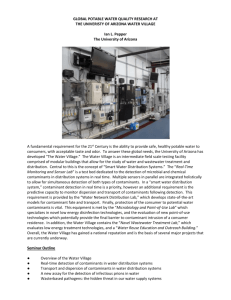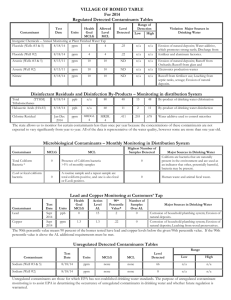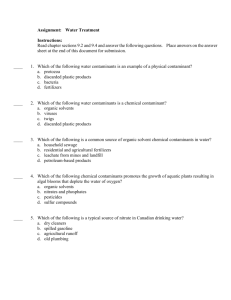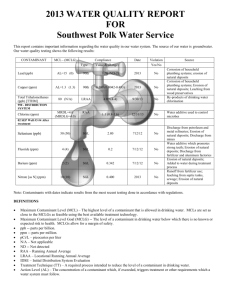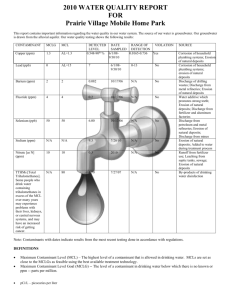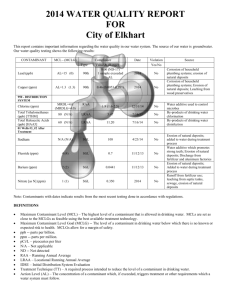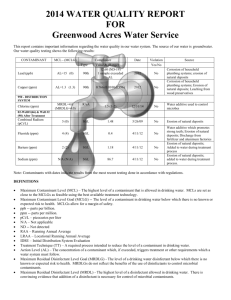June 2013 to May 2014 - Village of Kingsley, Michigan
advertisement
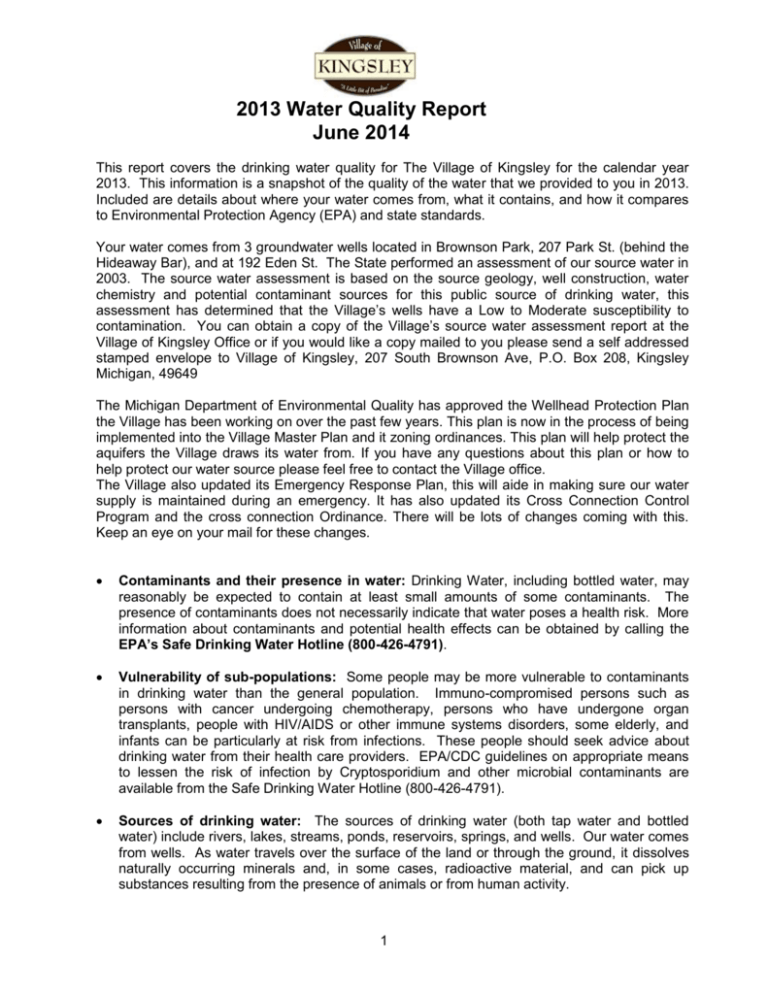
2013 Water Quality Report June 2014 This report covers the drinking water quality for The Village of Kingsley for the calendar year 2013. This information is a snapshot of the quality of the water that we provided to you in 2013. Included are details about where your water comes from, what it contains, and how it compares to Environmental Protection Agency (EPA) and state standards. Your water comes from 3 groundwater wells located in Brownson Park, 207 Park St. (behind the Hideaway Bar), and at 192 Eden St. The State performed an assessment of our source water in 2003. The source water assessment is based on the source geology, well construction, water chemistry and potential contaminant sources for this public source of drinking water, this assessment has determined that the Village’s wells have a Low to Moderate susceptibility to contamination. You can obtain a copy of the Village’s source water assessment report at the Village of Kingsley Office or if you would like a copy mailed to you please send a self addressed stamped envelope to Village of Kingsley, 207 South Brownson Ave, P.O. Box 208, Kingsley Michigan, 49649 The Michigan Department of Environmental Quality has approved the Wellhead Protection Plan the Village has been working on over the past few years. This plan is now in the process of being implemented into the Village Master Plan and it zoning ordinances. This plan will help protect the aquifers the Village draws its water from. If you have any questions about this plan or how to help protect our water source please feel free to contact the Village office. The Village also updated its Emergency Response Plan, this will aide in making sure our water supply is maintained during an emergency. It has also updated its Cross Connection Control Program and the cross connection Ordinance. There will be lots of changes coming with this. Keep an eye on your mail for these changes. Contaminants and their presence in water: Drinking Water, including bottled water, may reasonably be expected to contain at least small amounts of some contaminants. The presence of contaminants does not necessarily indicate that water poses a health risk. More information about contaminants and potential health effects can be obtained by calling the EPA’s Safe Drinking Water Hotline (800-426-4791). Vulnerability of sub-populations: Some people may be more vulnerable to contaminants in drinking water than the general population. Immuno-compromised persons such as persons with cancer undergoing chemotherapy, persons who have undergone organ transplants, people with HIV/AIDS or other immune systems disorders, some elderly, and infants can be particularly at risk from infections. These people should seek advice about drinking water from their health care providers. EPA/CDC guidelines on appropriate means to lessen the risk of infection by Cryptosporidium and other microbial contaminants are available from the Safe Drinking Water Hotline (800-426-4791). Sources of drinking water: The sources of drinking water (both tap water and bottled water) include rivers, lakes, streams, ponds, reservoirs, springs, and wells. Our water comes from wells. As water travels over the surface of the land or through the ground, it dissolves naturally occurring minerals and, in some cases, radioactive material, and can pick up substances resulting from the presence of animals or from human activity. 1 Contaminants that may be present in source water include: Microbial contaminants, such as viruses and bacteria, which may come from sewage treatment plants, septic systems, agricultural livestock operations and wildlife. Inorganic contaminants, such as salts and metals, which can be naturally-occurring or result from urban stormwater runoff, industrial or domestic wastewater discharges, oil and gas production, mining or farming. Pesticides and herbicides, which may come from a variety of sources such as agriculture and residential uses. Radioactive contaminants, which can be naturally occurring or be the result of oil and gas production and mining activities. Organic chemical contaminants, including synthetic and volatile organic chemicals, which are by-products of industrial processes and petroleum production, and can also, come from gas stations, urban stormwater runoff, and septic systems. In order to ensure that tap water is safe to drink, EPA prescribes regulations that limit the amount of certain contaminants in water provided by public water systems. Food and Drug Administration regulations establish limits for contaminants in bottled water, which provide the same protection for public health. Water Quality Data The tables listed on the following pages list all the drinking water contaminants that we detected during the 2013 calendar year. The presence of these contaminants in the water does not necessarily indicate that the water poses a health risk. Unless otherwise noted, the data presented in this table is from testing done January 1 – December 31, 2013. The State allows us to monitor for certain contaminants less than once per year because the concentrations of these contaminants are not expected to vary significantly from year to year. All of the data is representative of the water quality, but some are more than one year old. Terms and abbreviations used below: Maximum Contaminant Level Goal (MCLG): The level of a contaminant in drinking water below which there is no known or expected risk to health. MCLGs allow for a margin of safety. Maximum Contaminant Level (MCL): The highest level of a contaminant that is allowed in drinking water. MCLs are set as close to the MCLGs as feasible using the best available treatment technology. Maximum Residual Disinfectant Level (MRDL): The highest level of a disinfectant allowed in drinking water. There is convincing evidence that addition of a disinfectant is necessary for control of microbial contaminants. Maximum Residual Disinfectant Level Goal (MRDLG): The level of a drinking water disinfectant below which there is no known or expected risk to health. MRDLGs do not reflect the benefits of the use of disinfectants to control microbial contaminants. N/A: Not applicable ND: not detectable at testing limit, ppb: parts per billion or micrograms per liter ppm: parts per million or milligrams per liter pCi/l: pico curies per liter (a measure of radioactivity). Action Level: The concentration of a contaminant, which, if exceeded, triggers treatment or other requirements that a water system must follow. 2 Samples Collected at the Wellhouse: Regulated Chemical Contaminants MCL MCLG Our Water Sample Date Violation Yes / No Typical Source of Contaminants Arsenic (ppb)1 10 0 ND - 3 2012 No Erosion of natural deposits Chloride 250 250 2-50 2013 No Erosion of natural deposits Iron .3 .3 ND-.27 2013 No Erosion of natural deposits Fluoride (ppm) 4 4 ND 2013 No Erosion of natural deposits Nitrate (ppm) (as Nitrogen) 10 10 ND-3.4 2013 No Runoff from fertilizer use; leaching from septic tanks, sewage; erosion from natural deposits 1 These arsenic values are effective January 23, 2006. Until then, the MCL is 50 ppb and there is no MCLG. Contaminant Fecal coliform or E. Coli Susceptible Vulnerable Subpopulation Infants, young children, the elderly and people with severely compromised immune supplies. People with Wilson’s Disease. Children. Infants and children. Infants below the age of six months. Infants below the age of six months. Level of Concern Confirmed Presence Copper 1.3 mg/l (ppm) Fluoride 4.0 mg/l (ppm) Lead 15.0 μg/l (ppb) Nitrate 10.0 mg/l (ppm) Nitrite 1.0 mg/l (ppm) Notes: • Confirmed presence means that the routine distribution system sample or the repeat sample was total coliform-positive or fecalpositive or E. coli-positive and the other sample (routine distribution system sample or repeat sample) was fecal-positive or E. colipositive. • ppm parts per million; ppb parts per billion • Health effects language is found in R 325.10405. Radioactive Contaminants MCL MCLG Our Water Sample Date Violation Yes / No Typical Source of Contaminants Alpha emitters (pCi/L) 15 0 <3 2002 No Erosion of natural deposits Combined radium 226 / 228 (pCi/L) 5 0 <1 2002 No Erosion of natural deposits Unregulated Chemical Contaminants2 Our Water Sample Date Violation Yes / No Typical Source of Contaminants Sodium (ppm) 2.5-20.4 2013 N/A Erosion of natural deposits Sulfate (ppm) 9-17 2013 N/A Erosion of natural deposits 2 Unregulated contaminants are those for which EPA has not established drinking water standards. Monitoring helps EPA to determine where certain contaminants occur and whether it needs to regulate those contaminants. 3 Samples Collected in the Distribution System: Contaminants Subject to an Action Level Action Level Our Water Sample Date Number of Samples Above AL Typical Source of Contaminants Lead (ppb) 3 AL = 15 .11 2011 0 Corrosion of household plumbing systems; Erosion of natural deposits .46 2011 0 Corrosion of household plumbing systems; Erosion of natural deposits; Leaching from wood preservatives .07-.71 2013 0 Water additive used to control microbes MCL=.060 ND-.005 2013 0 Byproduct of drinking water disinfection MCL=.080 ND-.0123 2013 0 Byproduct of drinking water disinfection Copper (ppm) 3 AL = 1.3 Free Chlorine Residual (ppm)4 MRDL = 4.0 Haloacetic Acids Total Trihalomethanes 3 90 MRDLG = 4 percent of the samples collected were at or below the level reported for our water. MRDL and MRDLG are effective January 1, 2004. Compliance is based on an annual average 4 The If present, elevated levels of lead can cause serious health problems, especially for pregnant women and young children. Lead in drinking water is primarily from materials and components associated with service lines and home plumbing. The Village of Kingsley is responsible for providing high quality drinking water, but cannot control the variety of materials used in plumbing components. When your water has been sitting for several hours, you can minimize the potential for lead exposure by flushing your tap for 30 seconds to 2 minutes before using water for drinking or cooking. If you are concerned about lead in your water, you may wish to have your water tested. Information on lead in drinking water, testing methods, and steps you can take to minimize exposure is available from the Safe Drinking Water Hotline at 1-800-426-4791or at http://water.epa.gov/drink/info/lead/index.cfm. Monitoring and Reporting Requirements: The State and EPA require us to test our water on a regular basis to ensure its safety. We met all the monitoring and reporting requirements for 2010. Microbial Contaminants MCL MCLG Positive Samples Violation Yes / No Typical Source of Contaminants Total Coliform Bacteria 1 positive monthly sample (5% of monthly samples positive) 0 0 No Naturally present in the environment Fecal Coliform and E. coli Routine and repeat samples are total coliform positive, and one is also fecal or E. coli positive 0 0 No Human and animal fecal waste Chlorine or Chloramines Feb Mar .24 .20 .18 .35 .43 .36 N/A for RAA in year covered By the CCR Jan Bacteriological sample site #1 Bacteriological sample site #2 Average of all measurements taken in the month Chlorine or Chloramines Bacteriological sample site #1 Bacteriological sample site #2 Average of all measurements taken in the month RAA calculated quarterly of 12 monthly averages .19 .31 .25 .48 .20 .34 .19 .16 .18 April .43 .19 .31 May .50 .30 .40 .07 .10 .09 .71 .61 .66 .26 Previous June .34 .42 .38 Aug .13 .36 .245 Sept .15 .17 .16 Oct .33 .07 .20 Nov .32 .45 .385 Year Covered by the CCR .08 .20 .12 .06 .10 .24 .07 .15 .18 .03 .07 .05 .18 .07 .13 .10 .21 .16 .27 4 Year July .31 .21 .365 .13 Dec .27 .24 .255 .21 .17 .19 .16 Due to computer issues the Village was unable to access and send testing records for the monthly testing to the MDEQ, this resulted in a Drinking Water Violation from the MDEQ. The samples all had been taken and this posed no risk to the drinking water. These problems have all been resolved. The Village of Kingsley Department of Public Works is located at the Wastewater Treatment Facility site. The address of this location is 6426 N. Summit City Rd. The DPW phone number is 231-263-7777. Please feel free to call with any questions. We will update this report annually and will keep you informed of any problems that may occur throughout the year, as they happen. Copies of this report are available at The Village of Kingsley office located at 207 South Brownson Ave. We invite public participation in decisions that affect drinking water quality. If you have any questions for the Village Council they meet regularly the second Monday of every month @ 7:00pm. For more information about your water, or the contents of this report, please contact Terry Almquist from the Village of Kingsley Public Works Department at 231-263-7777 or 231-883-2058 or the Village of Kingsley Office at 231-263-7778. For more information about safe drinking water, visit the U.S. Environmental Protection Agency at www.epa.gov/safewater/. Quick facts about your water system. In the calendar year 2013 the Village of Kingsley pumped 85,161,200 gallons of water. The date of the highest water usage was June 29, where we pumped 849,000 gallons of water. The date of the lowest water usage was October 15, where we pumped 44,000 gallons of water. The difference between the highest and the lowest is made up of mostly irrigation and usage from the Slash Pad in Brownson Park! The blue water tower located behind the library holds 150,000 gallons of water. The light brown water tower located just east of the Village holds 200,000 gallons of water. The water levels between the 2 towers are identical. The water pressure throughout the Village is from strictly the elevation of the water towers, there are no pressure pumps. A gallon of water weighs 8.34 pounds, a gallon of milk weighs 8.6 Pounds 2.31 feet of water equal 1 pound per square inch (psi) 1 foot of water equals .433 pound per square inch (psi) 5
